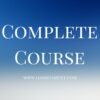Description
GSCM 588 Mid-Term Study Guide
TCO A
- Learn the importance of Quality Management.
- Examine the different types of process management tools for process improvement.
- Deming – Plan / Do / Check / Act (pg 463)
- DMAIC – Define / Measure / Analyze / Improve / Control (pg 468)
- Understand how an organization can implement and utilize the techniques of ISO 9000, Baldridge and Six Sigma (pg 543).
- Determine the differences between Six Sigma and Lean principles.
- Analyze how an organization can sustain the quality organization.
- Compare and contrast the evolution of quality and the role it played in the management of U.S. and Japanese business firms from the 1950s to the present.
- Explain the three core principles of total quality.
- The finance function is responsible for:
- Discuss how a fast-food restaurant could measure its quality effectiveness using each of the following definitions of quality: product-based, user-based, value-based, and manufacturing-based.
- Describe the relationship between quality and personal values.
- Differences between TQM and Six Sigma.
TCO B
- Define the effects process management (p 208) has on continuous improvement processes.
- Analyze the linkage of the Baldridge Award, Six Sigma, Lean Principles, and ISO 9000 with continuous improvement processes (pg 543).
- Understand the differing goals for design development (p. 311) and optimization (p. 344).
- Analyze the effects of ISO 9000 (pg 79) and Six Sigma on quality processes.
- Review the usage of statistics to assist in controlling quality and performance.
- Understand the need to manage processes utilizing statistical process control (pg 403).
- What are measures are tracked by senior leadership to gauge overall organization performance?
- Why is it difficult to obtain a single, universal definition of quality?
- Explain each of the following statements as they apply to modern quality management.
- Customer service is the rule, not the exception.
- The absence of defects is a given rather than a source of competitive advantage.
TCO C
- Analyze the effects of lean manufacturing and Six Sigma on quality processes.
- Identify the industries that are using total quality management processes.
- Analyze the principles of TLF (Taguchi Loss Function) and QFD (p 317) (Quality Function Deployment)(p 328).
- Identify how TLF and/or QFD can aid in the design of new products and processes.
- Describe the principles of Six Sigma and the House of Quality.
- Describe the six basics steps to build the House of Quality. Describe where in the house are customer and technical requirements located. Explain why it is important for each area of the house to be linked.
- Terms such as “kanban”; “single minute exchange of dies”; and “Visual Controls” are most closely associated with:
- “Poka-yoke” focuses on two aspects:
- Deming states that knowledge is not possible without theory, and experience alone does not establish a theory. Explain this statement as it applies to management decision making.
- Compare and contrast the quality philosophies of Deming and Juran.
TCO D
- Understand the Malcom Baldridge Award and what the benefits are for the organizations that submit to it.
- The Six Sigma Problem Solving Approach contain the phases of:
- The Baldrige Award, as a tool for self-assessment provides what?
- The criteria for Performance Excellence for the Malcolm Baldrige award consist of a hierarchical set of categories, items, and areas to address.
TCO E
- Identify the effects that total quality has on customer satisfaction and loyalty.
- Explain the reasons for focusing on customer satisfaction with respect to total quality.
- Evaluate some of the tools that can be used to analyze the different ways to understand the customer and their needs.
- Suggested reasons why many customer satisfaction efforts fail include:
- “Moments of truth” are instances when:
- According to Kano’s classification of customer requirements, a cup of coffee that is served hot and fresh at a restaurant specializing in breakfasts fits which class of customer requirements?
TCO F
- Compare the effects that leadership has on implementing and sustaining total quality (pg 635).
- Explain why change (p 665) is necessary in organizations. Describe the effects that change can have on quality management with respect to employee commitment and quality levels.
- Characteristics of effective strategic leadership include all of the following:
TCO G
- Identify the linkages between leadership, employee involvement (p 161), and empowerment (pg 167).
- Analyze the importance of developing and training employee involvement cultures to support quality management.
- Discuss the three major reasons why companies adopt total quality. Discuss the initial key steps involved in the adoption process.
- Cite three ways that middle management can impede an organization’s transition towards a total quality environment. Why is it important that middle management be supportive of a total quality initiative?
- Discuss the concept of best practices and their effect on quality management success (pg 671).
TCO H
- Identify and discuss five differences between service and manufacturing organizations (pg 23).
- Identify and discuss the five key dimensions of service quality.
- Discuss how front-line employees are critical to customer assessment of service quality. Identify the challenges faced by front-line employees.
Additional
- Focusing on how to maintain improvements occurs in which DMAIC phase?
- What criteria is used to classify a failure cost as “internal” versus “external”. Give 3 examples of each.
- Benchmarking – (pg 232).
- Affinity Diagrams – (pg 110).
- 5. Gap Model – (pg 112)
- 6. Customer-Focused Processes (pg 113)
- Customer Contact Requirements (pg 115).
- Actionable responses.
- Measuring Customer Loyalty (pg 129).
- Net Promoter Score (NPS) – (pg 130).
- Customer-Perceived Value – (pg 130).
- Why Customer Satisfaction Efforts fail – (pg 129)
- Voice of the Customer (pg 106).
- ASQ Quality Glossary Definition of Customer Service (pg 98).
- Customer Engagement (pg 98).
- Consumers, Internal/External Customers (pg 100).
- Conditions of Collaboration (p 157).





